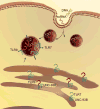How location governs toll-like receptor signaling - PubMed (original) (raw)
How location governs toll-like receptor signaling
Akanksha Chaturvedi et al. Traffic. 2009 Jun.
Abstract
Toll-like receptors (TLRs) are a family of innate immune system receptors responsible for recognizing conserved pathogen-associated molecular patterns (PAMPs). PAMP binding to TLRs initiates intracellular signaling pathways that lead to the upregulation of a variety of costimulatory molecules and the synthesis and secretion of various cytokines and interferons by cells of the innate immune system. TLR-induced innate immune responses are a prerequisite for the generation of most adaptive immune responses, and in the case of B cells, TLRs directly regulate signaling from the antigen-specific B-cell receptor. The outcome of TLR signaling is determined, in part, by the cells in which they are expressed and by the selective use of signaling adaptors. Recent studies suggest that, in addition, both the ligand recognition by TLRs and the functional outcome of ligand binding are governed by the subcellular location of the TLRs and their signaling adaptors. In this review we describe what is known about the intracellular trafficking and compartmentalization of TLRs in innate system's dendritic cells and macrophages and in adaptive system's B cells, highlighting how location regulates TLR function.
Figures
Figure 1. Trafficking of intracellular TLRs to endolysosomes
UNC93B physically interacts with the transmembrane domain of intracellular nucleotide-sensing TLRs, TLR7 and TLR9 in the endoplasmic reticulum. UNC93B1 regulates the trafficking of TLR7 and TLR9 to the endolysosomes upon stimulation with ssRNA or DNA.
Figure 2. Compartmentalized signaling of TLR4
TLR4 binds to LPS-MD2 complexes and engages MyD88- TIRAP adaptors at the cell surface leading to activation of early MAP kinase pathway. TLR4-LPS complex is endocytosed through a dynamin-dependent pathway terminating the MyD88-TIRAP signaling. TLR4-LPS complex within the endosome initiates a second phase of signaling by engaging TRAM-TRIF adaptors that leads to the production of interferon-β.
Figure 3. Synergistic responses of BCR and TLR9 in B cells to DNA-containing antigens
Crosslinking of BCR through DNA-containing antigens, initiates signaling resulting in the recruitment of TLR9 from endosomes to the autophagosomes in a PLD-dependent manner. TLR9 colocalizes with internalized antigen-BCR complexes within the autophagosomes and initiate synergistic signaling to NF-κB activation and MAP kinase phosphorylation.
Similar articles
- [Innate immunity: structure and function of TLRs].
Delneste Y, Beauvillain C, Jeannin P. Delneste Y, et al. Med Sci (Paris). 2007 Jan;23(1):67-73. doi: 10.1051/medsci/200723167. Med Sci (Paris). 2007. PMID: 17212934 French. - Toll-like receptors (TLRs) in aquatic animals: signaling pathways, expressions and immune responses.
Rauta PR, Samanta M, Dash HR, Nayak B, Das S. Rauta PR, et al. Immunol Lett. 2014 Mar-Apr;158(1-2):14-24. doi: 10.1016/j.imlet.2013.11.013. Epub 2013 Nov 28. Immunol Lett. 2014. PMID: 24291116 Review. - Toll-like receptors.
Takeda K, Akira S. Takeda K, et al. Curr Protoc Immunol. 2015 Apr 1;109:14.12.1-14.12.10. doi: 10.1002/0471142735.im1412s109. Curr Protoc Immunol. 2015. PMID: 25845562 - Interdependencies between Toll-like receptors in Leishmania infection.
Shukla D, Patidar A, Sarma U, Chauhan P, Pandey SP, Chandel HS, Bodhale N, Ghosh SK, Guzman CA, Ebensen T, Silvestre R, Sarkar A, Saha B, Bhattacharjee S. Shukla D, et al. Immunology. 2021 Sep;164(1):173-189. doi: 10.1111/imm.13364. Epub 2021 May 26. Immunology. 2021. PMID: 33964011 Free PMC article. - Important aspects of Toll-like receptors, ligands and their signaling pathways.
Chang ZL. Chang ZL. Inflamm Res. 2010 Oct;59(10):791-808. doi: 10.1007/s00011-010-0208-2. Epub 2010 Jul 1. Inflamm Res. 2010. PMID: 20593217 Review.
Cited by
- Proteolytic disassembly of viral outer capsid proteins is crucial for reovirus-mediated type-I interferon induction in both reovirus-susceptible and reovirus-refractory tumor cells.
Katayama Y, Terasawa Y, Tachibana M, Mizuguchi H, Sakurai F. Katayama Y, et al. Biomed Res Int. 2015;2015:468457. doi: 10.1155/2015/468457. Epub 2015 Mar 19. Biomed Res Int. 2015. PMID: 25866783 Free PMC article. - The Use of Toll-Like Receptor Agonists in HIV-1 Cure Strategies.
Martinsen JT, Gunst JD, Højen JF, Tolstrup M, Søgaard OS. Martinsen JT, et al. Front Immunol. 2020 Jun 11;11:1112. doi: 10.3389/fimmu.2020.01112. eCollection 2020. Front Immunol. 2020. PMID: 32595636 Free PMC article. Review. - Molecular pathways: toll-like receptors in the tumor microenvironment--poor prognosis or new therapeutic opportunity.
Ridnour LA, Cheng RY, Switzer CH, Heinecke JL, Ambs S, Glynn S, Young HA, Trinchieri G, Wink DA. Ridnour LA, et al. Clin Cancer Res. 2013 Mar 15;19(6):1340-6. doi: 10.1158/1078-0432.CCR-12-0408. Epub 2012 Dec 27. Clin Cancer Res. 2013. PMID: 23271799 Free PMC article. Review. - Characterization of markers, functional properties, and microbiome composition in human gut-derived bacterial extracellular vesicles.
Li CC, Hsu WF, Chiang PC, Kuo MC, Wo AM, Tseng YJ. Li CC, et al. Gut Microbes. 2023 Dec;15(2):2288200. doi: 10.1080/19490976.2023.2288200. Epub 2023 Dec 1. Gut Microbes. 2023. PMID: 38038385 Free PMC article. - Toll-like receptors and B-cell receptors synergize to induce immunoglobulin class-switch DNA recombination: relevance to microbial antibody responses.
Pone EJ, Zan H, Zhang J, Al-Qahtani A, Xu Z, Casali P. Pone EJ, et al. Crit Rev Immunol. 2010;30(1):1-29. doi: 10.1615/critrevimmunol.v30.i1.10. Crit Rev Immunol. 2010. PMID: 20370617 Free PMC article. Review.
References
- Janeway CA, Jr, Medzhitov R. Innate immune recognition. Annu Rev Immunol. 2002;20:197–216. - PubMed
- Ferrandon D, Imler JL, Hoffmann JA. Sensing infection in Drosophila: Toll and beyond. Semin Immunol. 2004;16(1):43–53. - PubMed
- Iwasaki A, Medzhitov R. Toll-like receptor control of the adaptive immune responses. Nat Immunol. 2004;5(10):987–995. - PubMed
- Jin MS, Kim SE, Heo JY, Lee ME, Kim HM, Paik SG, Lee H, Lee JO. Crystal structure of the TLR1-TLR2 heterodimer induced by binding of a tri-acylated lipopeptide. Cell. 2007;130(6):1071–1082. - PubMed
MeSH terms
Substances
LinkOut - more resources
Full Text Sources
Other Literature Sources


